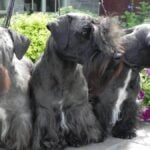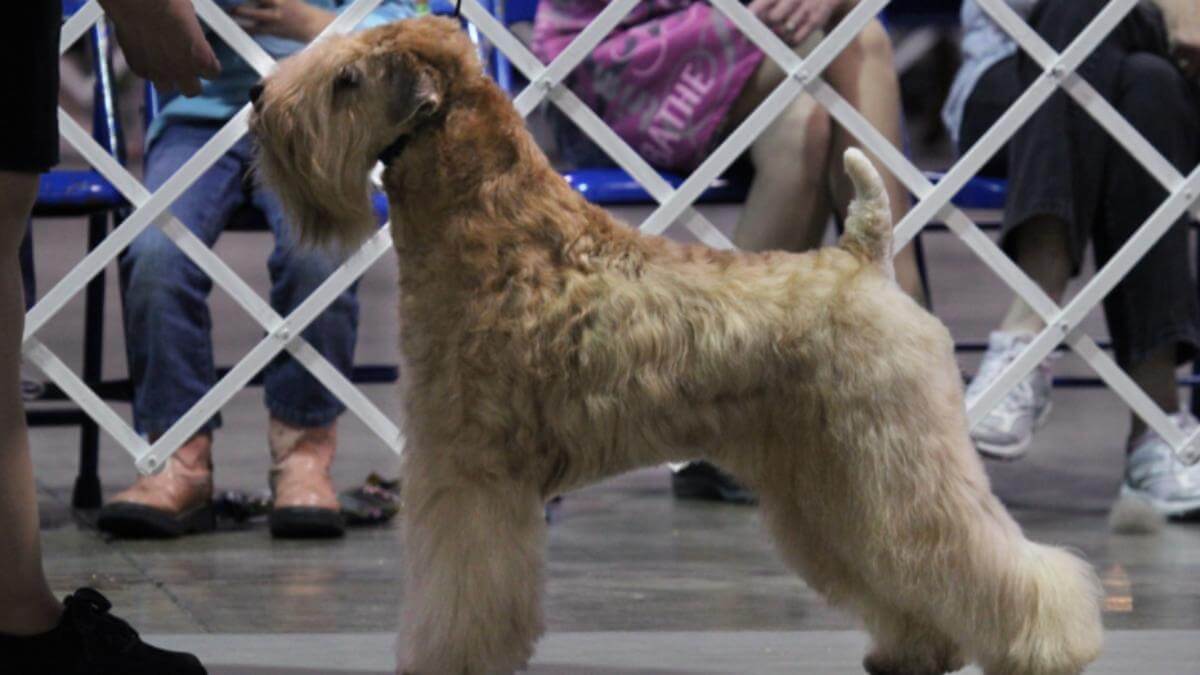
Home » Is That a Soft Coated Wheaten Terrier?

This article was originally published in Showsight Magazine, February 2018 issue.
I have been asked this question many times during the past forty-nine years. Fortunately, it has always been in public parks or on walks and never in the show ring. My first Soft Coated Wheaten Terrier was wrong in every way. I bought him in 1969 and had great plans for sweeping the miscellaneous classes with my beautiful dog. After all, the newspaper ad promised a show quality pup, perfect in every way, from fine old Irish stock. What he turned out to be was a walking, growling exception to every principle we hold dear in our breed’s description of type. While he won his first two shows, I still learned very quickly that he was not what I wanted to be showing. I feel very sorry for our new enthusiasts who win big with their first dog, especially if it is professionally handled. They miss out on all the great learning experiences available to those of us who start with dogs that we are willing to admit are less than perfect.
What really matters is that breeders and exhibitors actually have the desire to learn, and that they search out the best mentors; people who have bred consistent correct type, those that have bred multiple winners, and who are good teachers. In 1969, we Wheaten folk were still feeling our way toward AKC recognition and the development of a Breed Standard. In 1973, the year of AKC recognition, there were 33 entries at the Montgomery County Kennel Club show and the entries could easily have represented 15 different breeds. Abby’s Postage Dhu O’ Waterford owned by Marjorie Shoemaker led the way, winning the dog points three of the first four shows to become the first breed champion. By 1990 the special’s ring at Montgomery was a totally different story due to the breeding and grooming influence of one great dog, Ch Gleanngay Holliday, and by the expert trimming and handling directed by his breeder, Gay Sherman (Dunlap), and executed by Penny Belviso. Those who didn’t breed to him trimmed their dogs to look like him and those who couldn’t trim, hired handlers who either could, or thought they could. We were excited that at last we were developing breed type. 1990 marked another important milestone in breed history. As president of the Soft Coated Wheaten Terrier Club of America, I suggested that the Board authorize the development of an Illustrated Standard and that Gay Dunlap chair the project. She and illustrator, Jody Sylvester, made the club proud with a booklet still considered an example of a best practice.
Wheaten enthusiasts and judges alike stand to learn everything they need to know about what distinguishes a Wheaten Terrier from other breeds if they would but study this illustrated standard and use the information objectively. 1990 also marked the beginning of the importation of Irish dogs, followed by European dogs, the latter primarily of Irish descent. The objective of most breeders was to water down the intense gene pool that was producing illnesses that were killing off noticeable numbers of the breed. But we soon found that the imported dogs brought with them other issues. The FCI standard is not the same as the AKC standard and health testing was not carried forth in Ireland or in parts of Europe as it was in the US. Some imported dogs were also carrying genes for black or grey coloring that had been eliminated years before here.
The 2017 Best of Breed rings at the Delaware Valley Specialty held with Bucks County Kennel Club and at the SCWTCA specialty held with the Montgomery County Kennel Club Show certainly showed improvement from 1973 and some succeeding as well, but there are some obvious issues.
Presentation is a problem that isn’t going to be improved by better breeding practices. Actually a better dog under the coat would help. It would be great if exhibitors understood the meaning of two words, moderation and blending. Breeders and exhibitors would benefit from reading the Illustrated Standard and then watching the specialty video. Note that beards and falls are bizarre on many dogs. Many tuck-ups are not blended but appear as curtains under the body and don’t begin to follow the lines of the dog. Yes, it is easier to critique than to do the actual work but the very best way to learn is to observe and then to practice. Some things can be helped with the use of a quality shampoo, more practice grooming, moving the dog between snips etc. But,if you don’t have a picture in your mind’s eye of a really great Wheaten, whether you be judge, breeder or professional handler, the results will not be great.
Let’s go back to the Illustrated Standard. It won’t produce miracles but will provide a guide for evaluating dogs, picking the right puppy, grooming well and quite possibly might lead to making better breeding decisions. The pages in the beginning of the booklet titled “Essence of SCWT Type”, pack major punch.
If the coat is all chopped off, it does not wave or flow. If it is too long, it flops. Watch dogs and emulate grooming that highlights the outline of the dog without coat flopping and getting in the way of the dog’s movement.. Bad grooming gives the illusion of movement issues that often aren’t there. Dull coats are not to be rewarded and there should be no gray in the adult coat nor should the beard or fall be black. We are talking about a Soft Coated Wheaten Terrier!
Square cannot be emphasized enough! Judges reward too many long, low dogs. Perhaps they are judging on movement but, in doing so, they are ignoring one of the four most important aspects of Wheaten type. A Wheaten should hold its square outline as it moves and should maintain a level top line. The Wheaten should hold its square outline as it moves and should maintain a level top line. The tail should be carried high and erect, straight up from the back with plenty of dog behind it. Imports will carry natural tails which may be carried forward over the back. To determine whether the tail is correct, visually dock it level to the top of the neck, where the neck joins the head. If the tail is erect to that point, it is correct. Dogs with long tails in classes other than OPEN were bred in the USA where docked tails are preferred. Wheatens are not sunlovers but they should show with erect tails. Overly aggressive or fearful dogs are not useful in breeding programs. Excuses made for poor temperament only harm the breed and its future.
The head is a rectangle, not a square skull with a rectangle attached. The skull and foreface should be equal in length. The cheeks and the skull should be smooth and clean on three sides. The ears should be small to medium… not large and hanging low. Terrier expression, often expressed with the ear carriage, is important on Wheatens just as it is on any other Terrier! The Wheaten should have ears set so that the tip is level with the outside corner of the eye. You should also see a big black nose.
A Wheaten should appear happy, but steady. Males should stand their ground when faced off, but should not appear aggressive. Relating the pictures in the Illustrated Standard to one’s own dog might prove difficult. It requires looking past the emotions of loving the puppy you have raised and seeing the dog that is in front of you. If that is possible, a true breeder lies within.